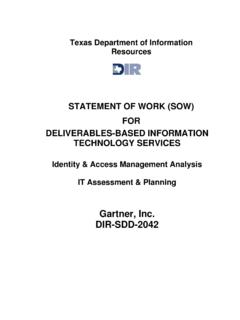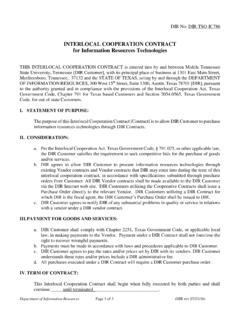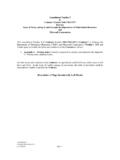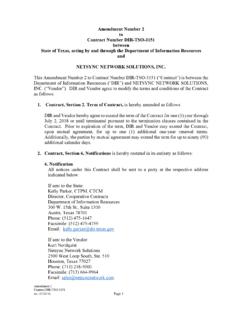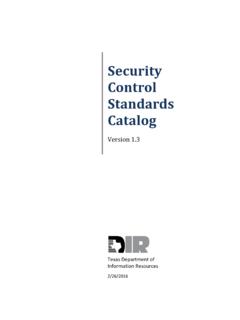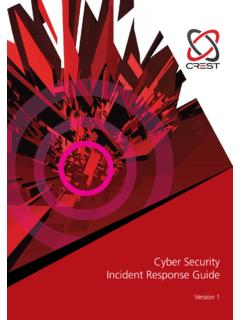Transcription of Incident Response Template - publishingext.dir.texas.gov
1 TEXAS DEPARTMENT OF INFORMATION RESOURCES. Incident Response Team Redbook January 2018. 1. Contents Introduction .. 3. SECTION 1 Glossary and Acronyms .. 4. Glossary .. 4. Common Acronyms .. 8. SECTION 2 Incident Response Policy .. 10. Sample Security Incident Response Policy .. 10. SECTION 3 Privacy/Security Event Initial Triage Checklist .. 12. SECTION 4 Event Threat, Impact Analysis, and Escalation Criteria .. 13. Event Threat and Impact Analysis .. 13. Event Escalation: Communication .. 14. SECTION 5 Breach Notice Criteria .. 16. SECTION 6 Post- Incident 20. SECTION 7 Incident Response Team Templates .. 21. Title and Contact Information for Plan Sponsor/Owner .. 22. IRT Charter .. 23. IRT Membership by Roles .. 25. IRT Meeting Minutes .. 27. IRT Action List .. 28. IRT State Government Contact Information.
2 29. SECTION 8 Additional Templates .. 30. Identity Theft Protection Criteria .. 31. Internal management Alert 33. Notice to Individuals Affected by Incident .. 34. Public (Media) Notice .. 37. SECTION 9 External Contacts .. 38. State of Texas Contacts .. 38. Federal Contacts .. 39. Industry Contacts .. 40. Press Contacts .. 42. SECTION 10 Legal References .. 43. Texas Laws and Regulations for Data Privacy and Security .. 43. Federal Laws and Regulations for Data Privacy and Security .. 45. Acknowledgements .. 50. 2. Introduction When a privacy or information security Incident occurs, it is imperative that the agency follow documented procedures for responding to and processing the Incident . An Incident Response Team (IRT) Redbook is intended to contain the procedures and plans for such incidents when they occur.
3 The Redbook should be in both hard copy and electronic formats and be readily available to any standing member of the IRT team. Two principles guide the establishment of the Redbook. One is that every agency must establish in advance and maintain a plan for responding to an Incident . Two, every agency must test and update the operation of the plan periodically to ensure that it is appropriate and functional. This is a Template and is intended to be a framework for state agencies in creating their own Redbook, and should be modified and completed to meet the business needs of the agency. Defined terms are in bold print. 3. SECTION 1. Glossary and Acronyms Glossary Admissible Evidence: evidence that is accepted as legitimate in a court of law, see Chain of Custody. Authentication: security measure designed to establish the validity of a transmission, message, or originator, or the identity confirmation process used to determine an individual's authorization to access data or computer resources.
4 Authorized User: a person granted certain permissions to access, manage, or make decisions regarding an information system or the data stored within. Authorized Use and Disclosure: a permissible action or use of Confidential Information. Authorization: the act of granting a person or other entity permission to use data or computer resources in a secured environment. Availability: The security objective of ensuring timely and reliable access to and use of information. Breach: an impermissible use or disclosure by an unauthorized person or for an unauthorized purpose that compromises the security or privacy of Confidential Information such that the use or disclosure poses a significant risk of reputational harm, theft of financial information, identity theft, or medical identity theft.
5 Depending upon applicable law, Breach may for example mean: 1) HIPAA Breach of Protected Health Information ( PHI ). With respect to PHI pursuant to HIPAA. Privacy and Breach Notification Regulations and regulatory guidance any unauthorized acquisition, access, use, or disclosure of PHI in a manner not permitted by the HIPAA Privacy Regulations is presumed to be a Breach unless a Covered Entity or Business Associate, as applicable, demonstrates that there is a low probability that the PHI has been compromised. Compromise will be determined by a documented Risk Assessment including at least the following factors: a. The nature and extent of the Confidential Information involved, including the types of identifiers and the likelihood of re-identification of PHI;. b. The unauthorized person who used or to whom PHI was disclosed.
6 C. Whether the Confidential Information was actually acquired or viewed; and d. The extent to which the risk to PHI has been mitigated. With respect to PHI, a Breach pursuant to HIPAA Breach Regulations and regulatory guidance excludes: a. Any unintentional acquisition, access, or use of PHI by a workforce member or person acting under the authority of a Covered Entity or Business Associate if such acquisition, access, or use was made in good faith and within the scope of authority, and does not result in further use or disclosure in a manner not permitted under the HIPAA Privacy Regulations. b. Any inadvertent disclosure by a person who is authorized to access PHI at a Covered Entity or Business Associate location to another person authorized to access PHI at the same Covered Entity or Business Associate, or organized health care arrangement as 4.
7 Defined by HIPAA in which the Covered Entity participates, and the information received as a result of such disclosure is not further used or disclosed in a manner not permitted under the HIPAA Privacy Regulations c. A disclosure of PHI where a Covered Entity or Business Associate demonstrates a good faith belief that an unauthorized person to whom the disclosure was made would not reasonably have been able to retain such information, pursuant to HIPAA Breach Regulations and regulatory guidance. 2) Breach in Texas. Breach means Breach of System Security, applicable to electronic Sensitive Personal Information (SPI) as defined by the Texas Identity Theft Enforcement and Protection Act, Business and Commerce Code Ch. 521, that compromises the security, confidentiality, or integrity of Sensitive Personal Information.
8 Breached SPI that is also PHI may also be a HIPAA. breach, to the extent applicable. 3) Any unauthorized disclosure as defined by any other law and any regulations adopted thereunder regarding Confidential Information. Business Continuity Plan: the documentation of a predetermined set of instructions or procedures that describe how an organization's business functions will be sustained during and after a significant disruption. Chain of Custody: refers to the application of the legal rules of evidence and its handling. Confidential Information: Information that must be protected from unauthorized disclosure or public release based on state or federal law or other legal agreement. This includes any communication or record (whether oral, written, electronically stored or transmitted, or in any other form) that consists of or includes any or all of the following: 1) Federal Tax Information, sourced from the Internal Revenue Service (IRS) under an IRS data sharing agreement with the agency.
9 2) Personal Identifying Information;. 3) Sensitive Personal Information;. 4) Protected Health Information, whether electronic, paper, secure, or unsecure;. 5) Social Security Administration data, sourced from the Social Security Administration under a data sharing agreement with the agency;. 6) All non-public budget, expense, payment, and other financial information;. 7) All privileged work product;. 8) Information made confidential by administrative or judicial proceedings;. 9) All information designated as confidential under the laws of the State of Texas and of the United States, or by agreement; and 10) Information identified in a contract or data use agreement to which an agency contractor specifically seeks to obtain access for an Authorized Purpose that has not been made public.
10 Confidentiality: The security objective of preserving authorized restrictions on information access and disclosure, including means for protecting personal privacy and proprietary information. Containment: the process of preventing the expansion of any harmful consequences arising from an Incident . Contingency management Plan: a set of formally approved, detailed plans and procedures specifying the actions to be taken if or when particular circumstances arise. Such plans should include all eventualities ranging from key staff absence, data corruption, loss of communications, virus infection, 5. partial loss of system availability, etc. 6. Data: information in an oral, written, or electronic format that allows it to be retrieved or transmitted. Disaster Recovery Plan: a crisis management master plan activated to recover IT systems in the event of a disruption or disaster.

